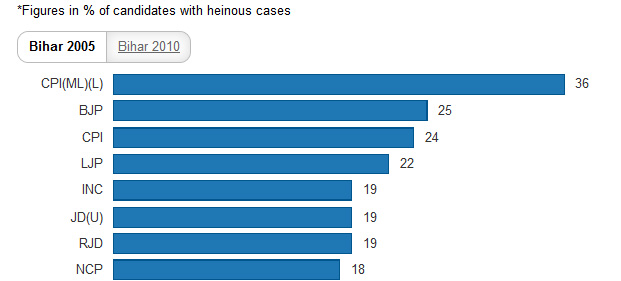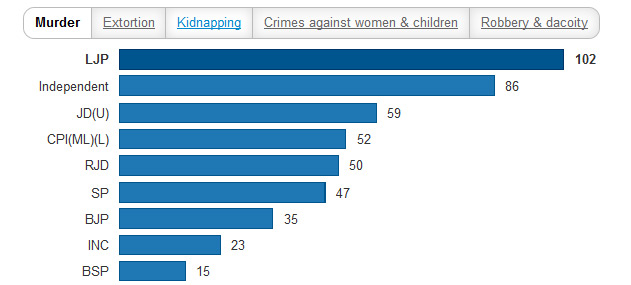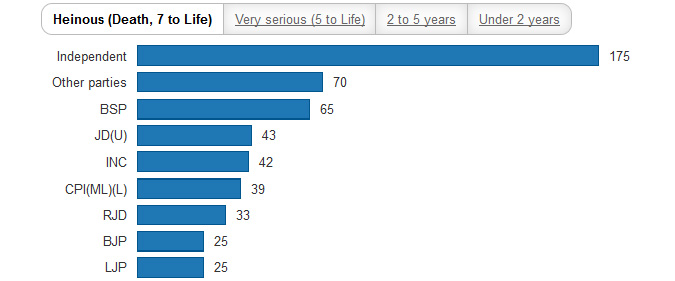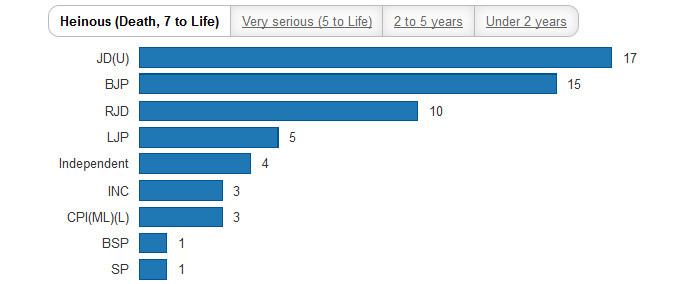
If the past two elections are any indication, candidates for the forthcoming assembly elections in Bihar are likely to have a string of “heinous” cases against them in court: murder, extortion, kidnapping, robbery and dacoity and crimes against women, including rape.
All political parties–there are no exceptions–pick candidates with serious criminal charges. Why they do that is revealed by an IndiaSpend analysis of self-declared affidavits: Only 8% of candidates without criminal cases against them won in 2005. In 2010, only 4% did. While the success rate of tainted candidates in both 2005 and 2010 was 23% and 12% respectively.
While 274 (14%) of 2,029 candidates with “heinous” charges were given tickets in 2005, the figure rose to 600 (20%) of 3,058 candidates in 2010. In 2005, these 274 candidates had in total 499 murder charges, 81 extortion cases and 102 kidnapping charges. In 2010, the 600 candidates with heinous cases had charges that included 919 murder charges, 207 extortion cases and 151 kidnapping charges.
Fielding candidates with criminal cases is not a new practice among Indian political parties, but during the 2010 elections, 66 constituencies in Bihar had more than four candidates with “heinous” cases against them contesting the elections. There were 20 constituencies where six and more candidates contested the elections with “heinous” cases pending against them.
Janata Dal (United) leads the pack, but all parties guilty
In 2010, 34% of JD (U) candidates, 33% of LJP, 26% of BJP and 18% of Congress candidates told the Election Commission of India that they had cases involving crimes of a “heinous” nature pending against them.
Tainted Candidates, 2005 & 2010 Bihar Elections


Source: Self-sworn affidavits submitted by contesting candidates to ECI, Bihar Chief Electoral Officer 1, 2. View raw data here. Note: Heinous cases are those involving offences related to murder, extortion, kidnapping, robbery and dacoity, and crimes against women & children, including rape. If convicted for these offences, the punishment ranges from 7 years to life imprisonment or the death sentence.
While the issue of criminalisation in politics comes up during every election, what makes the issue more serious in the context of Bihar is the nature of crimes that the candidates have been facing.
In 2005, the BJP gave tickets to 26 candidates who declared 35 charges of murder, 16 of extortion, 7 of kidnapping, and five counts of robbery and dacoity.
Break-up Of Charges Against 2005 Candidates


Source: Self-sworn affidavits submitted by contesting candidates to ECI, Bihar Chief Electoral Officer 1, 2. View raw data here.
It became worse in 2010.
As many as 43 candidates of the JD(U), the party headed by Chief Minister Nitish Kumar, had 79 charges of murder, 20 of extortion, 11 of kidnapping, while 42 Congress candidates had 61 murder-related offences. The BJP gave tickets to 25 candidates who declared 47 murder charges, 12 extortion, 13 kidnapping and 2 cases of rape.
Break-up Of Charges Against 2010 Candidates


Source: Self-sworn affidavits submitted by contesting candidates to ECI, Bihar Chief Electoral Officer 1, 2. View raw data here.
Parties clearly choose candidates with the most serious charges
Of 2,029 candidates who contested the 2005 Bihar elections, 1,539 candidates were “clean”; they declared they did not have any criminal cases against them.
ALSO READ : Bihar polls: Sonia, Rahul unlikely to share dais with Lalu
Of the remaining 490, in addition to 274 candidates facing “heinous” cases, 113 were facing “very serious” cases, 36 candidates were facing cases where, if convicted, the maximum punishment would range between two to five years and 67 candidates were facing cases with a maximum punishment of less than two years.
These figures point to the fact that the degree of taint also matters for political parties.
Of the candidates facing criminal cases, 56% (274 of 490) faced “heinous” cases and 23% (113 of 490) faced “very serious” charges.
Parties chose candidates facing grievous charges (for which the maximum punishment if convicted is more 5 years and can be up to life imprisonment or death sentence) than the ones that had lesser punishments, if convicted.
Break-up Of 2005 Candidates By Potential Punishment


Source: Self-sworn affidavits submitted by contesting candidates to ECI, Bihar Chief Electoral Officer 1, 2. View raw data here.
Similarly, during the 2010 Bihar elections, of the 1,207 candidates with pending criminal cases, 50% (600 of 1,207) had heinous cases and another 28% (340 of 1,207) had “very serious” cases pending against them.
So, parties prefer to give tickets to candidates who have “heinous” and “very serious” charges pending against them.
Break-up Of 2010 Candidates By Potential Punishment


Source: Self-sworn affidavits submitted by contesting candidates to ECI, Bihar Chief Electoral Officer 1, 2. View raw data here.
Only 8% of clean candidates won in 2005; 4% in 2010
It's clear why parties chose candidates with criminal records.
Of the 1,539 “clean” candidates who contested the 2005 assembly elections in Bihar, only 126 (8%) were elected; 22% of candidates with “heinous” cases won–61 of 274.
Of 113 candidates facing “very serious” charges (including rioting, cheating and forgery), 23 (20%) made it to the assembly. This means candidates with “heinous” and “very serious” charges had around three times better chances of winning elections in Bihar than “clean” candidates.
Break-up Of 2005 MLAs By Potential Punishment Faced


Source: Self-sworn affidavits submitted by contesting candidates to ECI, Bihar Chief Electoral Officer 1, 2. View raw data here.
The success rate of “clean” candidates worsened during the 2010 elections–no more than 4% (82 of 1,851) won.
The success rate for candidates facing “heinous charges” was 11% and for candidates with “very serious” cases 12%, again three times better chances of victory than candidates with no criminal records.
Break-up Of 2010 MLAs By Potential Punishment Faced

Source: Self-sworn affidavits submitted by contesting candidates to ECI, Bihar Chief Electoral Officer 1, 2. View raw data here
(Manoj K is a graduate of the Indian Institute of Technology, Delhi, and the founder of the Centre for Governance and Development. He has a special interest in transparency and accountability in governance and has spearheaded several projects on these subjects. He can be contacted at manoj@cgdindia.org.
Madan is a commerce and law graduate from the University of Delhi. He has previously worked with McKinsey India and the United Nations High Commissioner for Refugees. He is currently practising as an advocate in the Delhi High Court.)
(Indiaspend.org is a data-driven, public-interest journalism non-profit)



















